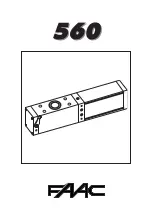
6050-065-D-2-16
20
3.3 DIP-Switch Definitions
Switches 1-2
These work in conjunction with each other and determine when the relay on the board will be activated. This relay can be used as a
switch for various functions such as illuminating a warning light when the gate is moving, or turning on a green light when the gate is full open.
This relay is
NOT
available for these uses if it is being used for the SHADOW loop function.
Switch 3
Determines that a device wired to terminal #12 is a normal full open command
OR
terminal #12 becomes the output from the exit loop
detector that is plugged into the EXIT Loop port in the circuit board (Used for specialized functions).
Switch 4
Turns the auto close timer on or off. Maximum time that the close timer adjustment can be set for is approximately 23 seconds.
Switch 5
is
NOT
used. Leave in the
OFF
position.
Switch 6
Sets up the circuit board for single button (ON setting)
OR
a DoorKing 3-button control station only (OFF setting). When this switch is
ON, terminals 13 and 14 can be used as a Normally Open
STOP
input for single button control. When this switch is OFF, terminals 13 and 14 can
be used with a DoorKing 3-Button control station
ONLY
for Open, Close and Stop input.
Switch 7
Sets up the circuit board for single or primary / secondary (dual) gate operation.
Switch 8
If the gate is forced open, the tamper-protect system will start the motor in the close direction when the operator senses the forced open
condition.
SW 4 (Top 8 Switches)
1
23
Switch 1
Must OPEN
the
primary
operator’s gate upon initial AC power up and open command. If the
FIRST
open command begins to close
the gate, turn AC power off and reverse this switch.
Switch 2
Must OPEN
the
secondary
operator’s gate upon initial AC power up and open command. If the
FIRST
open command begins to close
the gate, turn AC power off and reverse this switch. This switch will be set the opposite of switch 1 (e.g. If switch 1 is OFF, then switch 2 will
be ON).
Switch 3
This switch is
not used.
Leave in OFF position.
Switch 4
This switch applies high voltage motor power to the secondary operator motor terminal located at the top of the board (See page
17). If a primary / secondary system is in use, this switch should be
ON
and the secondary motor wires connected to the secondary operator
motor terminal. For single gate applications, this switch can be turned
OFF
.
Switch 5
This switch sets the input at Terminal 15 to act as a normal reverse input
OR
to act as a shadow input. A shadow input will only hold
the gate operator in the open position once it is in the full open position. A shadow input
will not
reverse the direction of the gate operator
once it begins its close cycle.
Switch 6
Used in primary / secondary applications, turning this switch ON will cause the secondary operator to start 1-2 seconds before the
primary operator. This allows the secondary gate to reach the full closed position before the primary gate, which is desirable when the gates
are constructed with an overlap or if a magnetic lock is used to secure the gates.
Switch 7
Turn this switch ON when a
MONITORED Photo Sensor
is wired to aux terminals #7 - #8. Photo sensor is active in
CLOSE
direction
of gate travel.
Switch 8
Turn this switch ON when a
MONITORED Reversing Edge OR Photo Sensor
is wired to aux terminals #9 - #10. Sensor is active in
BOTH
directions of gate travel.
Monitored Sensor LEDs
One Sensor ONLY
Connection #7 & #8
One Sensor ONLY
Connection #9 & #10
10
9
8
7
6
5
4
3
2
1
AUX Terminal
Monitored Sensor LEDs
LED ON:
Connected device has been activated. LED remains off during normal operation.
One LED Flashing:
Connected device is in fault. Wiring to device is bad.
Both LEDs Flashing:
Both connected devices are in fault.
SW 3 (Bottom 8 Switches)
Summary of Contents for Series 6050
Page 41: ...6050 065 D 2 16 37...
















































